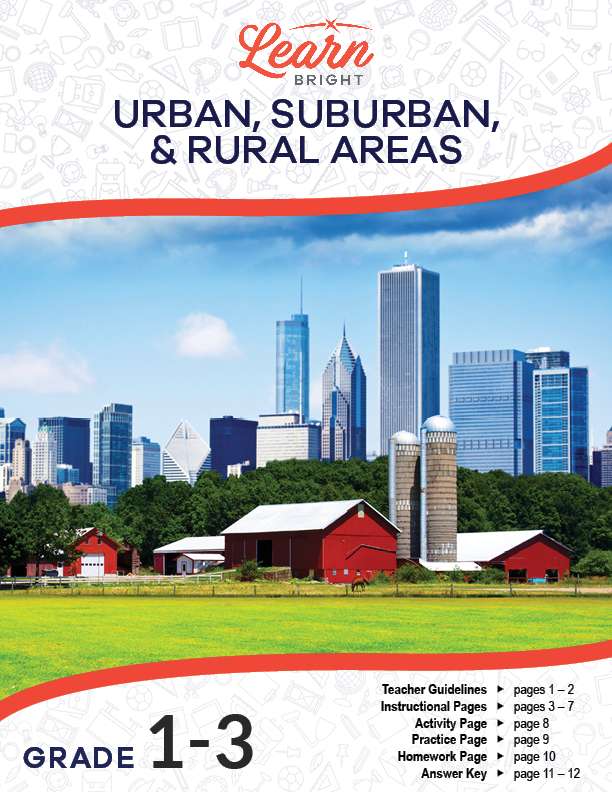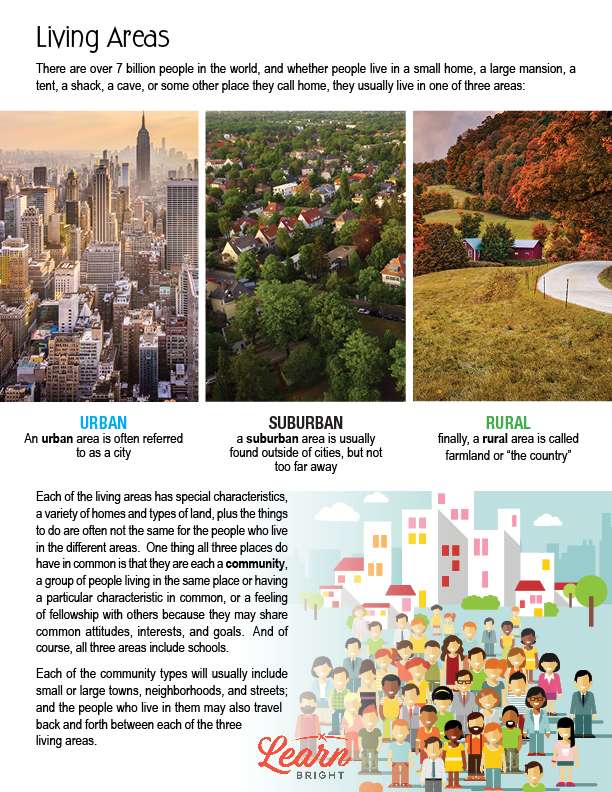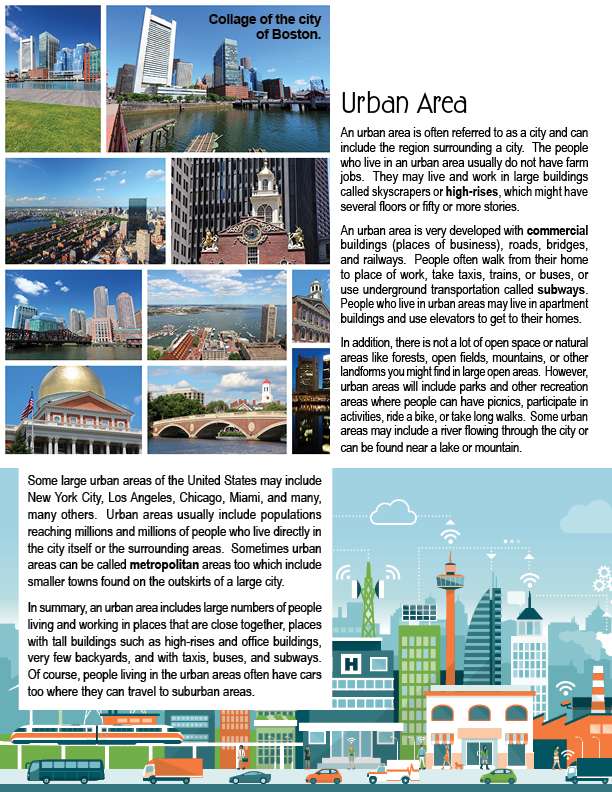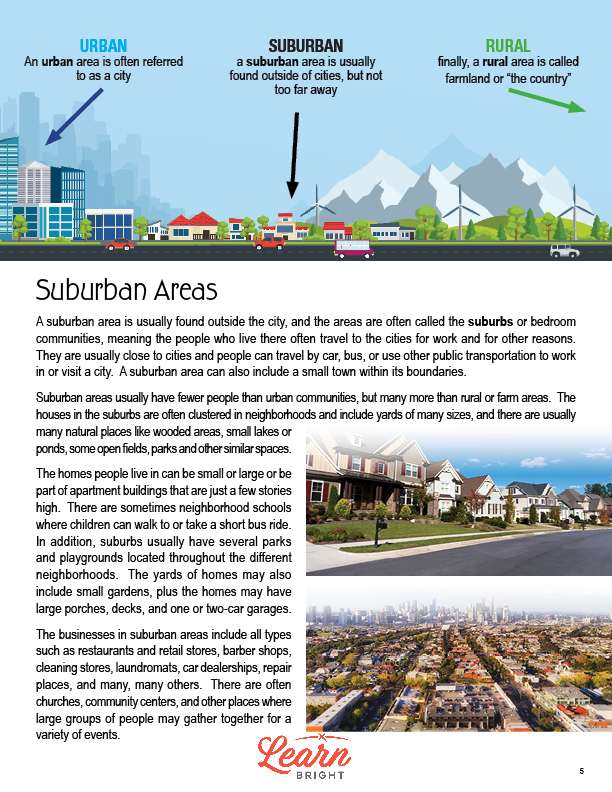Description
What our Urban, Suburban, and Rural Areas lesson plan includes
Lesson Objectives and Overview: Urban, Suburban, and Rural Areas lesson plan introduces students to the three community types and their differences. Many students may have heard the three terms before but may not understand the differences. They should also become aware of what is the same between the different communities, and that many people generally have the same goals in life, regardless of where they live. At the end of the lesson, students will be able to define, identify, and compare urban, suburban, and rural areas. This lesson is for students in 1st grade, 2nd grade, and 3rd grade.
Classroom Procedure
Every lesson plan provides you with a classroom procedure page that outlines a step-by-step guide to follow. You do not have to follow the guide exactly. The guide helps you organize the lesson and details when to hand out worksheets. It also lists information in the orange box that you might find useful. You will find the lesson objectives, state standards, and number of class sessions the lesson should take to complete in this area. In addition, it describes the supplies you will need as well as what and how you need to prepare beforehand. The supplies you will need for this lesson are colored pencils, drawing paper, scratch paper, and the handouts.
Options for Lesson
Included with this lesson is an “Options for Lesson” section that lists a number of suggestions for activities to add to the lesson or substitutions for the ones already in the lesson. One optional addition to this lesson is to use resource videos to take students on “field trips” of each type of community. You could also take a real field trip to a different type of community, such as farm or city or suburb, than where your school is located. You could choose one student from each community type and have the other students ask questions about their community, trying to recognize the differences and similarities. Finally, you could invite a farmer, city dweller, or suburbanite to speak to the class on the same day about where they live.
Teacher Notes
The teacher notes page includes a paragraph with additional guidelines and things to think about as you begin to plan your lesson. This page also includes lines that you can use to add your own notes as you’re preparing for this lesson.
URBAN, SUBURBAN, AND RURAL AREAS LESSON PLAN CONTENT PAGES
Living Areas
The Urban, Suburban, and Rural Areas lesson plan includes five content pages. The 7 billion people in the world live in different types of homes and places. Most people live in one of three types of areas: urban (cities), suburban (areas found outside of, but nearby, cities), or rural (farmland or “the country”).
Each of these types of areas has its own set of characteristics, different kinds of homes and land, and different things to do. However, all of these kinds of places are communities, or groups of people living in the same general area who have some characteristics in common. They may have similar attitudes, interests, and goals. All of these places also have schools.
Each of these types generally include small or large towns, neighborhoods, and streets. The people who live in them often travel between the different types of living areas.
Urban Areas
We often call urban areas cities, and might include the region surrounding a city. The people who live there usually don’t farm, but rather live and work in large buildings like skyscrapers or high-rises, which can have many floors.
Urban areas have lots of commercial buildings, roads, bridges, and railways. People can usually walk to their place of work and travel by public transportation (buses, trains, and subways) or taxis. People who live in these areas typically live in apartment buildings and might use elevators to get to their homes.
Urban areas generally don’t have a lot of open space or natural areas like forests, fields, or mountains. However, they do have parks and other recreation areas where people can picnic, ride a bike, or go on walks. Some urban areas might have rivers flowing through them or might be near mountains or lakes.
Some urban areas in the United States include New York City, Los Angeles, Chicago, Miami, and more. They usually have large populations in the millions and include many people who live both directly in the city or in the immediate surrounding areas. We sometimes call urban areas metropolitan areas, which include smaller towns on the outskirts of a large city.
Urban areas include large numbers of people who live and work close together. They have tall buildings, few backyards, taxis, and public transportation. Some people living in urban areas have cars that they use to travel to suburban areas.
Suburban Areas
We usually find suburban areas outside of a city. People call them the suburbs or bedroom communities, because people who live in them often travel into cities for work and for activities. You find them near cities. People can travel into the city using cars or, sometimes, public transportation like buses. Suburban areas can include a small town.
Suburban areas generally have less people than cities, but more than rural or farm areas. You can find suburban houses in neighborhoods with yards. They generally have some wooded areas, lakes or ponds, open fields, parks, and other places like that.
People can live in small or large homes, or small apartment buildings. Children can sometimes walk to neighborhood schools or take a bus. Suburbs usually have parks or playgrounds in their neighborhoods. Yards can include gardens, and homes can include porches, decks, and garages.
Suburban areas have many different businesses, like restaurants and retail stores, barber shops, cleaning stores, laundromats, car dealerships, repair shops, and more. They also have churches, community centers, and other places for people to gather.
Suburban areas usually have medium-sized communities. We can find them near large cities and they include different sizes and types of homes that might have yards, lawns, and garages. Fewer people live in them than in cities. They have parks, fields, and places to shop. People living in the suburbs can travel to cities and to rural areas.
Rural Areas
Rural areas include places with farms and wide-open space. Some people think of rural areas as “the country.” We include farmlands in rural areas throughout the U.S. The people who live there grow or raise most of the food for the country. People need the food produced in these areas to live.
Fewer people live in rural areas than in suburbs or cities. You can generally find people’s homes further apart. There’s open space or natural areas like forest or farmlands, lakes, ponds, and open fields.
People in rural areas live in large or small homes, with some built on large areas of land. The people who live here might be farmers or people who drive to their jobs in suburbs or cities.
Some rural areas do not have paved roads, so people might drive pickup trucks. Farm owners and workers might use special vehicles to help grow and harvest crops, like tractors or other machinery.
Some rural areas might have a small town with a few businesses, which helps rural people not have to travel far for necessities. In the United States and elsewhere, some rural areas become suburban areas when they use farmland to build neighborhoods and houses because a nearby city increases in population.
Rural areas have open land, farms and forests, and fewer homes and people than urban and suburban places. Their homes can be far apart. Sometimes, they host state fairs. People from urban and suburban places can visit them to learn about farming and daily life in rural areas.
All kinds of places have schools where children go to learn, though they can take longer to get to in rural areas. It’s important to respect where everyone is from, even if they’re from a different kind of place. Each type of community is different, but everyone who lives in them wants a good life with their family and friends.
URBAN, SUBURBAN, AND RURAL AREAS LESSON PLAN WORKSHEETS
The Urban, Suburban, and Rural Areas lesson plan includes three worksheets: an activity worksheet, a practice worksheet, and a homework assignment. You can refer to the guide on the classroom procedure page to determine when to hand out each worksheet.
HOME DESIGN ACTIVITY WORKSHEET
The activity worksheet asks students to design and draw a home found in a rural, suburban, or urban community. They will include the area around the home, words to help describe the image, and more.
Students can also work in pairs or groups to complete this activity. You can also have them create a 3D model of their home.
WHICH COMMUNITY PRACTICE WORKSHEET
For the practice worksheet, students will first tell whether they would most likely find each person, place, or other item in a rural, suburban, urban area, or all places. They will then describe each type of community.
URBAN, SUBURBAN, AND RURAL AREAS HOMEWORK ASSIGNMENT
The homework assignment asks students to answer ten questions about the lesson material. They will also look at three pictures and will decide which type of community each looks like and why.
Worksheet Answer Keys
This lesson plan includes answer keys for the practice worksheet and the homework assignment. If you choose to administer the lesson pages to your students via PDF, you will need to save a new file that omits these pages. Otherwise, you can simply print out the applicable pages and keep these as reference for yourself when grading assignments.









